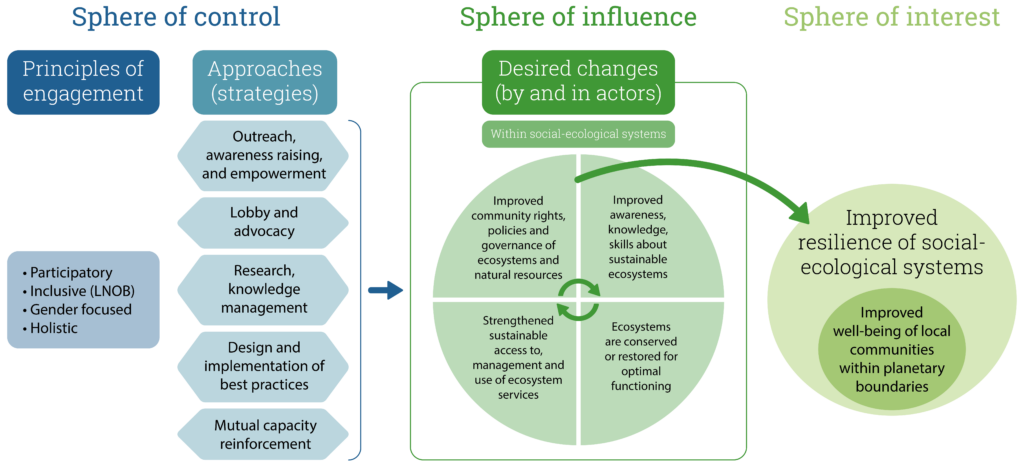
Below we give some key definitions on social-ecological resilience, why it is important and how SECORES addresses this theme. We find a lot of inspiration in the Stockholm Resilience Centre. For useful links and internal or external documents, please click here.
- Why is this important?
- What is the link with the SDGs
- How does SECORES works on social-ecological resilience?

Some definitions
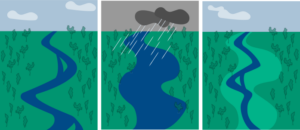
Resilience
“The ability to cope with change and continue to develop”
(source: Stockholm Resilience Centre)
Ecosystem
“A dynamic entity of plant, animal and micro-organism communities and their non-living environment interacting as a functional unit”
(Source: Convention on Biological Diversity)
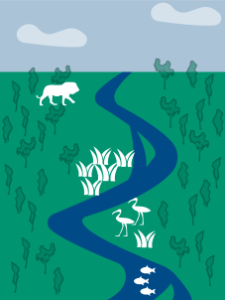
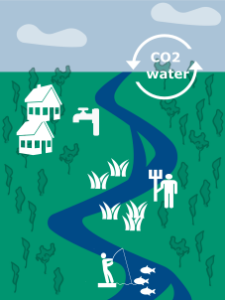
For a graphic overview of categories of ecosystem services and their link to human well-being, see IPBES publication ‘The regional assessment report on biodiversity and ecosystem services for Europe and Central Asia‘ (2018), page XXIII (25 in pdf)
(Source: IPBES – Intergovernmental Science-Policy Platform on Biodiversity and Ecosystem Services)
Ecosystem services
“The benefits that people derive from ecosystems”. We can distinguish 3 (or 4) groups of ecosystem services
- Regulatory (sometimes divided in regulatory and support services): this concerns habital maintanance; pollination; regulation of air quality, climate, ocean acidification, freshwater quantity and quality; formation of soils; regulation of hazards and organisms detrimental to humans
- Supply (material) services: this concerns food and feed, energy, materials and assistance and medicinal ressources
- Cultural (non-material) services: this concerns learning and inspiration, physical and psychological experiences, supporting identies and maintenance of options.
Ecosystem services link to human well-being. There is also a clear link to the ‘One Health’ approach.
Social-ecological systems
Linked systems of people and nature. The term emphasizes that humans must be seen as a part of, not apart from, nature; that the delineation between social and ecological systems is artificial and arbitrary.
(Source: Stockholm Resilience Centre)
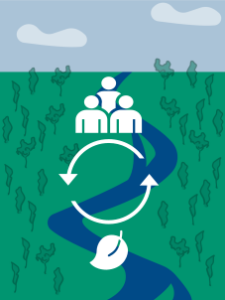
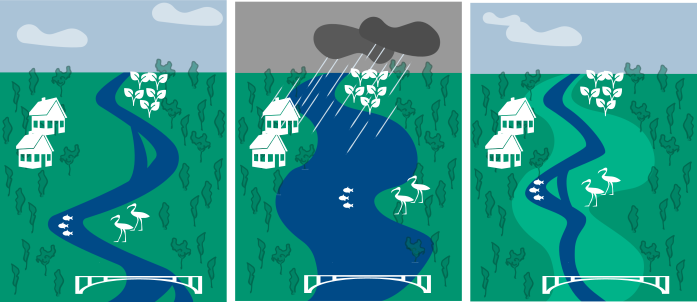
Social-ecological resilience
“The capacity to adapt or transform in the face of change in social-ecological systems, particularly unexpected change, in ways that continue to support human well-being”
(Source: Folke et al (2016) in Ecology and Society, Vol 21 No 3)

Why is this important?
Scientists proposed quantitative planetary boundaries within which humanity can continue to develop and thrive for generations to come. Crossing these boundaries increases the risk of generating large-scale abrupt or irreversible environmental changes. Since then the planetary boundaries framework has generated enormous interest within science, policy, and practice.
The nine boundaries are:
- Already crossed
- Climate change
- Biosphere integrity (crossed for extinction rate, not measured for XXX
- Freshwater use (crossed for green water, not yet for blue water)
- Land-system change
- Novel entities
- Biogeochemical flows (N and P)
- Not yet crossed
- Ocean acidification
- Stratospheric Ozone Depletion
- Not yet quantified
- Atmospheric aerosol loading
Further reading: https://www.stockholmresilience.org/planetary-boundaries
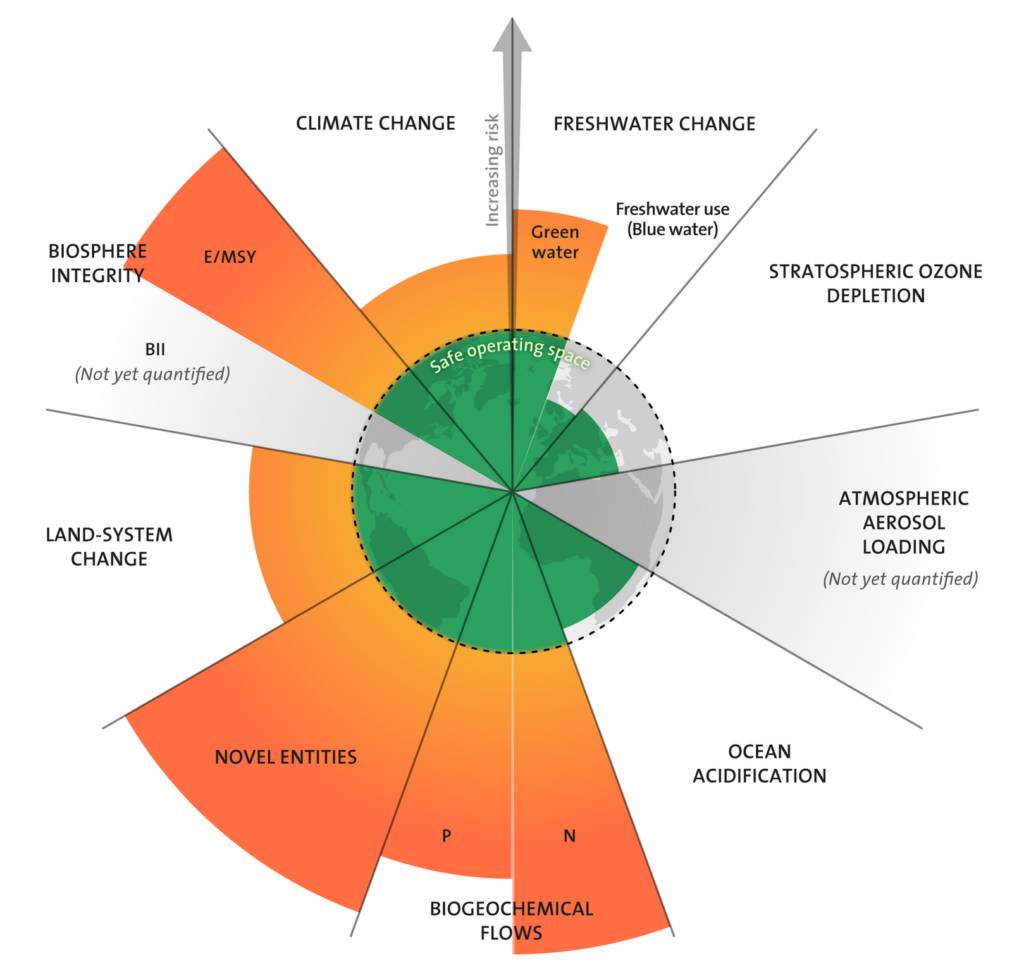
Source: Stockholm Resilience Centre, Credit: J. Lokrantz/Azote based on Steffen et al. 2015.

What is the link with the SDGs?
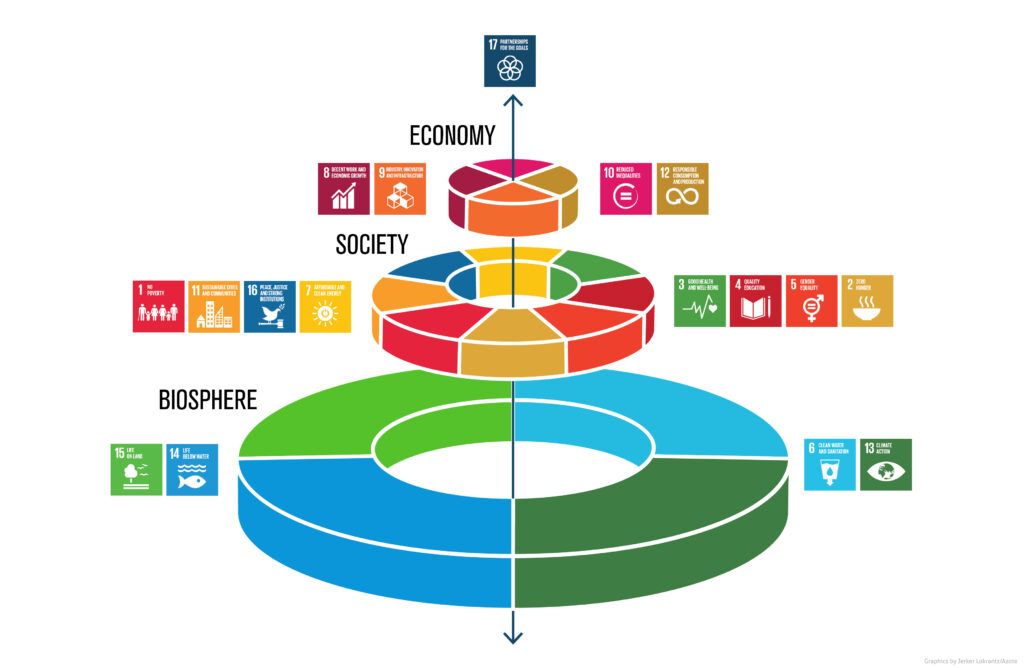
The Stockholm Resilience Centre uses a very good visual representation of the Sustainable Development Goals. The four SDGs linked to the biosphere are the basis for achieving the other goals (social and economic). These four SDGs are:
- 6 – clean water and sanitation;
- 13 – climate action;
- 14 – life below water; and
- 15 – life on land.
Source image: Rockström and Sukhdev, Stockholm Resilience Centre; Credit: Azote Images for Stockholm Resilience Centre

How does SECORES work on social-ecological resilience?
Conceptual framework
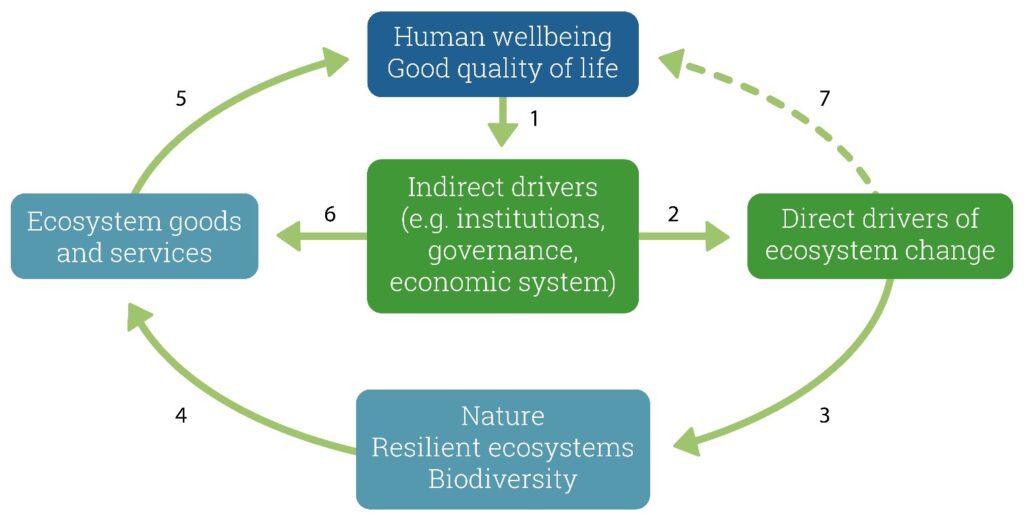
The conceptual framework in based on IPBES’ framework. It is a simplified representation of the highly complex interaction between the natural world and the human societies within the social-ecological system. This conceptual framework also forms the basis of the Theory of Change (TOC).
We follow the vision of the IPBES that the ethical and ecologically sustainable utilisation of nature are key components of the concept of human well-being. The way in which a society adopts this vision will be directly reflected in institutions, governance systems, economic systems, and other indirect drivers (link 1). This could be the existence of rights to land and water use, pollution control, regulations on use of ecosystems (hunting, extraction).
Indirect drivers affect the direct drivers of ecosystem change, for example, population size and lifestyle choices will influence the amount of land that is allocated to food crops, energy crops or cattle (link 2).
Direct drivers affect the ecosystem and thus their ability to deliver ecosystem goods and services which contribute to human well-being (link 3, 4 and 5).
Indirect drivers also modulate the link between nature and human well-being by regulating the access to and the use of ecosystem goods and services (link 6). Direct drivers also can impact human well-being directly, for example, pollutants or heat strokes not only impact ecosystems but can also impact human health (link 7).

Theory of Change
The next figure shows an overview of the TOC of SECORES, to be read from right to left.
- The ultimate change is the improved well-being of local communities within the planetary boundaries, thanks to improved resilience of social-ecological systems.
- The desired changes in the sphere of influence are
- improved community rights, policies, and governance of ecosystems and natural resources;
- improved awareness, knowledge, and skills about sustainable ecosystems;
- strengthened sustainable access to, management and use of ecosystem services
- ecosystems conserved or restored for optimal functioning.
- 10 types of actors have been identified; they can be allies to make changes happen but can also be targeted by these changes:
- (1) indigenous people and local communities; (2) individual consumers; (3) civil society
- (4) primary, secondary, technical, and vocational schools; (5) research institutes, universities and higher education
- (6) cooperation and development actors
- (7) local authorities; (8) national authorities; (9) multilateral and international organisations
- (10) private sector.
- 5 approches should be applied in the sphere of control: (a) outreach, awareness raising and empowerment; (b) lobby and advocacy; (c) research and knowledge management; (d) design and implementation of best practices; and (e) mutual capacity reinforcement.
- 4 principles of engagement support the whole process: (a) participation; (b) inclusion (leave no one behind); (c) focus on gender; and (d) a holistic approach.
